#tw aids
Text
As a queer Gen Z, I constantly think about how there’s such a huge chunk of the queer community that’s simply… missing. So much of the queer community died during AIDS that almost an entire generation of us is simply not there anymore.
Those queer people were supposed to be our teachers, our mentors, maybe even our parents or grandparents. Those queer people were supposed to be there for us. They were supposed to be at pride events, welcoming all the young queers. They were supposed to be representation in our careers. Those people were supposed to be there to help us navigate life as queer people, and it’s devastating for both us and them that they never got to do it.
8K notes
·
View notes
Text
I know this might hurt to hear for some but the ending of Falsettos is the necessary climax and conclusion to all of the men's character arcs.
Bill Finn didn't write it just to be a downer ending. He wrote it so Marvin would have to overcome his misogyny and take on a caregiving role and so he could learn to rely on his family for support.
He wrote it so Whizzer would have to overcome his pride and allow himself to be cared for and loved. To bring him and his family together.
He wrote it to knock Mendel down from his g-d complex. To show him he doesn't have the answers, that he has to help his family process their feelings instead of just pretending everything is fine.
He wrote it to teach Jason to give up his king, to concede, to learn from his mistakes. To teach him about being a man.
Whizzer's death happens at the end of Jason's bar mitzvah because it symbolizes all four men finally growing up. Becoming men. It is their final step out of falsettoland. Ignoring the ending robs them of their growth.
#this is why “whizzer lives” aus dont really work#bc they trap them in perpetual adolecence#or pretend their flaws never existed#falsettos#marvin falsettos#marvin trilogy#whizzer brown#mendel weisenbachfeld#jason falsettos#tw aids#tw death#tw illness#tw loss
1K notes
·
View notes
Text
Little Art things I'm obsessed with pt 1
Portraits of absent figures:

David Hockney - A Bigger Splash, 1967
Hockney originally visited California in 1963 and was won over by the sunlight and laid-back lifestyle, especially the luxury and ubiquity of the swimming pool. He described it as his "promised land"
The splash is about freezing a moment in time, but it is also empty of human presence but implying a human.
The male figure is present in some of David's other works from this time period, especially his muse and then-partner Peter Schlesinger. These paintings are about a hedonistic gay lifestyle, and the swimmers, the divers, are often the subject of voyeurism and desire. But in this painting, we just missed the diver, which makes the object of desire more private and personal. Who was the painter looking at, lusting after, etc.
I like the contrast of the incredibly sharp and graphic suburban neighborhood, and the chaotic, organic splash. So again, if the divers represent this homosexual desire, we have this contrast of an orderly heterosexual world, and the queerness that joyfully disrupts it.
And then of course, with the absent figure, there is this massive sense of loss and loneliness. And so much of loneliness is about concealment, hiding in shame. This is a private space, but its also an exposed space, enhancing the loneliness. The figure is isolated, alone, invisible. Its a sadness that contrasts with the setting, the activity, and saturated lighting.
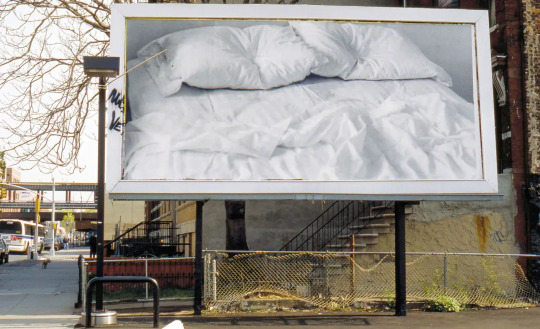
Felix Gonzalez-Torres - Untitled (billboard of an empty bed), 1991
These billboards were exhibited in the streets of Manhattan during the AIDS crisis. This piece was created the same year Felix Gonzalez-Torres's boyfriend Ross died. This portrait is a celebration of love and a memorization of loss and the emotions between intimacy and publicity. In the artist's own words:
“What I’m trying to say is that we cannot give the powers that be what they want, what they are expecting from us. Some homophobic senator is going to have a very hard time trying to explain to his constituency that my work is homoerotic or pornographic, but if I were to do a performance with HIV blood — that’s what he wants, that’s what the rags expect because they can sensationalize that, and that’s what’s disappointing. Some of the work I make is more effective because it’s more dangerous. We both make work that looks like something else but it’s not that. We’re infiltrating that look.“
The work intentionally uses the matching, identical depressions to imply a same-sex couple. The image itself is extremely intimate, but its being displayed in public spaces.
Felix Gonzales-Torres became known for his absent bodies.
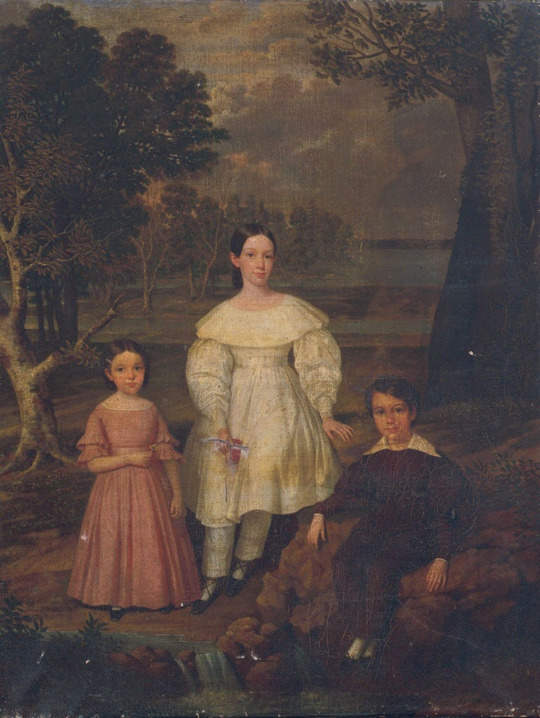
And then, a little different, this painting by Jacques Guillaume Lucien Amans (1837) commissioned by Frederick and and Coralie Frey, depicts the three Frey children, with the faint shadow of a figure. There was a legend that there was a fourth figure in this painting. In 2005 a private collector, Jeremy K Simien, purchased the painting and it underwent conservation.
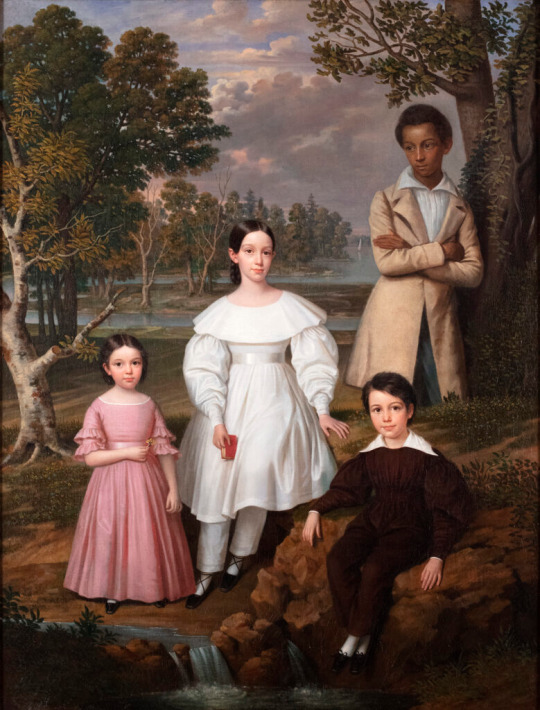
The painting revealed Bélizaire, a fifteen year-old enslaved domestic owned by the children's father. The picture captures the complex relationship between the boy and the children, the family that was keeping him captive. For one thing, the way he is set back from the others. There is this sort of intimacy between them along side the psychological trauma of forced bondage.
Here is a great Tiktok about the painting, to quote "What I'm struck by is what a sensitive portrait this is of this young man who was living in an inhumane society where he, despite being a human being, was bought and sold."
A few years after this painting was created, the three Frey children died, and Bélizaire was the only one who survived into adulthood.
The painting stayed in the Frey family. At some point, likely in the late 19th or 20th century, Bélizaire was intentionally painted over. In 1972, the great-granddaughter of Coralie Frey donated the painting to a Louisiana museum, informing them that a figure was painted over. During the course of the painting's life at the museum, no effort was put into restoring the figure.
Jeremy Simien's, who bought and restored this painting, said on his instagram "Bélizaire, they know your name now. Tell the ancestors to let me sleep for a minute."
And shout out to the picture that make me want to write this, Hyde Park Flowers, London by Tumblr user @kimironside I won't re-post it so check out the link.
#art#art history#felix gonzalez torres#belizaire#david hockney#Jacques Guillaume Lucien Amans#Jacques Amans#Jeremy K Simien#tw slavery#tw aids
1K notes
·
View notes
Text
Fun queer fact!
The reason why the letter L is at the front of the LGBTQ acronym is because during the aids pandemic lesbians weren't affected largely and were the primary caretakers of gay men who had received aids,
as a sign of solidarity they changed the acronym from GLBT to LGBT for not only the lesbians who helped care for those with aids, but the lesbians who had gotten aids aswell.
417 notes
·
View notes
Text
To put it very simply, I’m just saying one of the defining fears of the 80s being the AIDs crisis and November 1983 being just under a year after GRID (Gay-Related-Immune-Disease) was defined it makes it interesting that the demogorgan is a monster that makes you sick or kills you after you spill blood; often from unclean cuts, and targets queercoded characters like Will and Barb. Will who is called gay the entire show and Barb who dies because she's the only person at Steve's house that doesn't have (straight) sex (Tommy + Carol and Steve + Nancy). To add to this Will coming back sick and weak to further attacks and being bullied by being called a zombie (a creature that spreads a sickness to people through physical contact) not to mention all the implications of abuse with the mind flayed in s3. And this era-based homophobia is carried into the satanic panic era that begins in 85-86 based on reports of sodomy and is tackled in s4 with the next queercoded character; Eddie not only being the target of this moral panic but being introduced reading an article written about this panic that directly mentions sodomy. If Stranger Things is emulating the cultural fears of the 80s (it is and it’s very good at this) and you can see this with the Cold War and Russia in season 3 and the threat of nuclear war (with the Russian’s weapons building and the town cracking in pieces in s4) then it stands to reason that the AIDS crisis and the rampant homophobia in the 80s would be portrayed as well.
#very simplified but i wanted to sum up my thoughts#but just know this has been cooking for like two years if not more#st#mabel post#stranger things#will byers#barbara holland#barb holland#eddie munson#stranger things theory#tw aids#byler#(target audience for my posts)#byler tumblr#byler endgame#byler theory#steve harrington#nancy wheeler
105 notes
·
View notes
Text

Source: How Can You Write A Poem When You’re Dying Of AIDS? , edited by John Harold
#I feel in love with this poem#it’s so gorgeous#tw aids crisis#tw aids#gay male history#lgbt history#gay man#gay men#bisexual men#gay male art#gay poetry#gay trauma#poem#poetry#icarus#image#lgbt#gay#personal#quote
451 notes
·
View notes
Text
we need to talk about the long-term impact of the AIDS pandemic
aids has traumatized the queer community.
when i was 10 years old i didnt know i was queer yet. i never saw any queer people on tv. id never met any queer people, other than my uncle. i was aware that there had been a plague that killed a lot of gay people.
i honestly thought my uncle was the only survivor. i thought there were none of us left.
i didnt know queer people could live. all i knew was my uncle was gay, all his friends died of some disease that killed all the gays, and his mother wanted him to catch it too.
i didnt know there was a chance for us. when i realized i was queer it was terrifying. i thought i would end up like my uncle or his friends who died.
i had no idea that queer people could survive to old age.
i thought it was a death sentence.
even though im older now, im still traumatized. im still learning that i have a shot at life. im not going to die. but im still scared. i havent seen my uncle in years. i dont know any queer people old enough to have actually lived during the 80s.
its scary growing up knowing that people like you dont get old.
35 notes
·
View notes
Text
With the release of the Little Mermaid (2023) trailer, I want to tell you all about the gay man who saved Disney
After the death of Walt Disney in 1966 and Roy Disney in 1971, the Disney Animation Studio floundered for over a decade and a half. The movies released following the Disneys’ deaths did not do well at the box office or with critics, and the company began losing money quickly. It didn’t help that during the production of The Fox and The Hound, Don Bluth along with a bunch of other Disney animators left the company to start their own animation studio.
After The Fox and The Hound released in 1981, Michael Eisner (best known as the inspiration for Lord Farquad) took over after Walt Disney’s nephew resigned as CEO. Michael Eisner came into the company with the sentiment that they “had no obligation to make art”, and released The Black Cauldron in 1985 to critical and commercial failure. The company hit rock bottom and in response, Eisner moved the animation studio out of the buildings that were DESIGNED FOR ANIMATORS TO ANIMATE IN and into various hangers, warehouses, and trailers. Eisner was about to get rid of the animation studio for good until Walt Disney’s nephew intervened. Thanks to the mild success of The Great Mouse Detective and Oliver and Company, Eisner gave the animation studio another chance.
That’s where our man comes in.

Howard Ashman was born in Baltimore, Maryland in May of 1950. He and Alan Menken (the composer for many many many Disney films) collaborated on The Little Shop of Horrors. Ashman was the lyricists, librettist, and director of the project while Menken wrote the music. They were nominated for a Grammy Award and Ashman received a Drama Desk Award for Outstanding Lyrics. Ashman then wrote the screenplay for the Frank Oz film adaptation of the musical.
Ashman was brought in to Disney to write a song for Oliver and Company. While there, he was told about several projects the animation studio had on the back burner, one of which was The Little Mermaid.
Ashman became a driving force behind the creation of The Little Mermaid and subsequently, all of the Disney films made between 1989 and 1999. He explained to the animation team how musical theater and animated films were made for each other, and how they had the exact same amount of suspension of disbelief for audiences, which made them a perfect substitute for live action movie musicals which had gone out of fashion after the 1960s.
Ashman wrote all the lyrics to the songs in The Little Mermaid and insisted that Alan Menken be brought on to write the score and music. It was Menken’s first ever movie score and he fucking nailed it. Ashman was the one who insisted on bringing on actors who had musical theater backgrounds. He also insisted that Sebastian the crab be Jamaican so he could include Caribbean inspired music and have an “up” number during the movie. He explained to the writers how musicals were structured, where to include songs, and how those song would weave themselves into the story and feel natural. Ashman was credited as a producer on the film, which was released in 1989 to ENORMOUS SUCCESS. Ashman then went on to write the lyrics to the songs in Beauty and the Beast and three songs from Aladdin, the latter of which he pitched to Disney as an animated musical and wrote a treatment for.
After the release of The Little Mermaid, Ashman revealed to Menken that he had tested positive for HIV/AIDs. Jeffery Katzenburg, the then animation director at Disney, fully supported Ashman during the making of Beauty and the Beast, even creating a studio near his home in New York so he could work easier while receiving treatment. He got to see a private early screening of Beauty and the Beast before he lost his eyesight. He died of heart failure seven months before the film was released in November of 1991.
Beauty and the Beast received a standing ovation at its premiere and was the first and only animated movie to be nominated for Best Picture at the Oscars, a decade before the Best Animated Feature category was added. The film is dedicated to Howard Ashman, a message at the end of the film reading, "To our friend Howard, who gave a mermaid her voice and a beast his soul, we will be forever grateful.“ Beauty and the Beast won for Best Original Song at the Oscars, the award presented to Alan Menken and Howard Ashman. Ashman’s partner Bill Lauch accepted the posthumous award for Ashman, making it clear to the audience that he and Howard were a couple and loved each other. Disney was furious that Lauch had said those things during his acceptance speech.
Following Ashman’s death, the 2002 special DVD release of Beauty and the Beast added the song “Human Again” which Ashman and Menken wrote but was cut from the original film. The DVD also featured a special short called Howard Ashman: In Memorium. It features many people from the animation studio talking about Ashman and his invaluable contributions to the films he worked on. Jeffery Katzenburg said that there were two angels watching over them during his days at Disney: Walt Disney himself, and Howard Ashman.
If it weren’t for Howard Ashman, a gay man who died of AIDs in 1991, Disney would not be what it is today. They would have continued to flounder and eventually have gone under. Ashman brought Disney back to life and gave us unforgettable films and inspired countless others. He was the backbone of the Disney Renaissance, creator of the formula that these films followed and allowed them to succeed where previous films hadn’t.
And the modern Disney Corporation refuses to acknowledge his existence. While doing research for this post, I found a documentary on Disney+ about Howard Ashman. It has a one minute long trailer on the Disney+ YouTube account and that’s it. There’s no other marketing for this documentary, no one posting about it, NOTHING. It came out in 2018. FOUR YEARS AND NO ONE KNOWS IT EXISTS. Disney has been erasing the existence of queer people in their history and continue to profit off of the work that queer people did to keep their company afloat. The Beauty and the Beast remake was the first Disney movie to make over a billion dollars and in doing so, they butchered the work of a dying gay man who didn’t even get to see the finished film he worked so hard on.
So, as you make art and gif posts about The Little Mermaid (2023) as more and more trailers and promotional material come out for it, remember Howard Ashman. Remember the man who gave many of us our childhoods, who gave a mermaid her voice and a beast his soul.
Rest in peace, Howard.
Here is a video the goes more in depth about Howard’s contributions to Disney and the history surrounding the importance of The Little Mermaid:
undefined
youtube
#the little shop of horrors#little shop of horrors#the little mermaid#howard ashman#disney#disney animated movies#disney animated classics#disney renaissance#musical#musicals#movie musicals#movie musical#movie music#history#lgbt history#LGBT+ history#LGBT historical figures#lgbt+ historical figures#tw aids#tw death#tw gay death#tw disney#alan menken#walt disney#jeffery katzenburg#michael eisner#roy disney#roy o disney#roy e disney#beauty and the beast
221 notes
·
View notes
Text
oh i'm so upset i just thought of the tragedy potential of aziraphale and crowley living through the AIDS crisis.
beneath the cut i know this could be upsetting
obviously aziraphale is so very very gay, clockably outwardly gay and not afraid to show it. as someone presenting as a gay man, the aids crisis doesn't go unnoticed by him. he hurts for all the gay men dying without their families because that’s in some way a mirror of how he feels about crowley
he loves someone who his family (heaven) cast out and despises for being himself (coming out metaphor) who is apparently awful and repulsive (demonic, infected) and well as having a massive social stigma (literally being a representation of everything bad) is dying alone (Falling?, unforgivable) but is seen as somehow deserving of this (‘divine punishment for being queer’). the reluctance to touch people wth aids (again, demonicness, no affection for demons) the ostracisation of anyone who *could be* infected (gay men. aziraphale too).
Aziraphale knows full well the layers of metaphor in this. Of course, in another universe, Aziraphale could be one of those men. So could crowley, though neither of them could get sick now, as humans… if they lived a normal life… that could be them. the young man with nothing left in the world, dying in an awful hospital room where no-one wants to touch him or show him any affection could be crowley. aziraphale could be the one left behind with the awful guilt of it and also knowing it could be him too.
i wrote a little bit of a fic about this but i might continue it the metaphor potential but idk if it's too sad
#tw aids#tw homophobia#tw death#tw sickness#sorry for this one but. ough the implications#especially as the book was written in 1990... when aids was Very Much Still A Big Problem#sorry yeah this is quite dark
18 notes
·
View notes
Text
Being born after the AIDS crisis, it’s very easy for queer Gen Zs to feel alone and like we don’t have any role models. Gen Zs, we need to remember that our queer icons were there for us. They didn’t fail us, and they definitely didn’t abandon us. They were neglected by the government during a health crisis and left to die. They were TAKEN FROM US. They would’ve loved to be here for us now. They protected us so fiercely while they were alive and there’s no reason to believe they wouldn’t have continued hadn’t so many of them died.
OUR QUEER ICONS DIDN’T ABANDON US! THE GOVERNMENT ABANDONED THEM!
173 notes
·
View notes
Text
The BOM to Falsettos pipeline really scoops up every tween that's obsessed with Andrew Rannells and desensitizes them to AIDS jokes before plopping them down in a fandom with complicated themes they have no historical context for and making us babysit them
#like read the room#falsettos#falsettos 2016#marvin trilogy#idk if I'm brave enough to tag BOM#tw aids
64 notes
·
View notes
Text

A beautiful sign from the CDC museum.
#aids history#aids epidemic#queer history#lgbt history#gay history#tw homophobia#tw racism#drug ment tw#tw aids
95 notes
·
View notes
Text

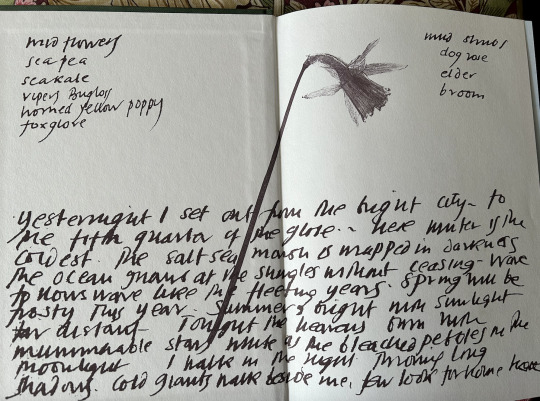


JOMP BPC - 20th February - LGBTQIA+
I suppose a book about a garden is an odd one for my lgbtqia+ choice. But it's a beautiful book about Derek Jarman making his garden in the wild, inhospitable environment of Dungeness - planting native plants in the salty shingle and making sculptures from the bits of driftwood and rusty metal he found there. And all of this in the shadow of the nuclear power station and his diagnosis of AIDS.
5 notes
·
View notes
Text
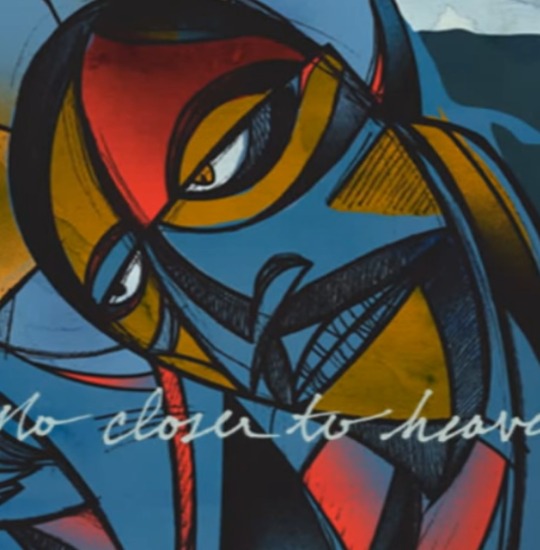

I Don't Like Who I Was Then (The Wonder Years)
Hidden in the tall grass in the naked light of day/I put my past-self in the ground/I’ve been dancing on the grave/I’m not the person that I was them/I’m tearing him away. I was bitter. I was careless. I was 19 and afraid/But you deserved more from me/I don’t know why I would say those things/You deserved more from me and I’m trying every day
"Acknowledging all your past mistakes and trying to grow and become someone that's new, and better. it's fucking hard. idk. it just captures that whole. Thing. it's hard to admit you were wrong and it's hard to face your old self. but fuck man, you can learn and grow from the things you hate. it's not always about forgiveness. sometimes you gotta hold yourself accountable and treasure your new self and acknowledge where you've done wrong. just feels. human. viscerally so."
Love Me Like There's No Tomorrow (Freddie Mercury)
Anything can happen/But we only have one more day together, yeah/Just one more day forever/So, love me like there's no tomorrow/Hold me in your arms, tell me you mean it/This is our last goodbye/And very soon it will be over/But today just love me like there's no tomorrow
"Just watch the music video. It is about Freddie Mercury beating AIDS and living happily with his boyfriend. Freddie Mercury, like so many men, did not survive AIDS."
Like There's No Tomorrow submitted by @gitrog
9 notes
·
View notes
Text

The first safe-sex poster in response to the AIDs Epidemic, 1983
#gay#lgbtq#queer#lgbt#lgbt pride#lgbtqplus#lgbt history#queer community#queer history#gay history#lgbtq history#tw aids#aids activism#aids history#aids epidemic#aids crisis#hiv aids#safe sex
20 notes
·
View notes